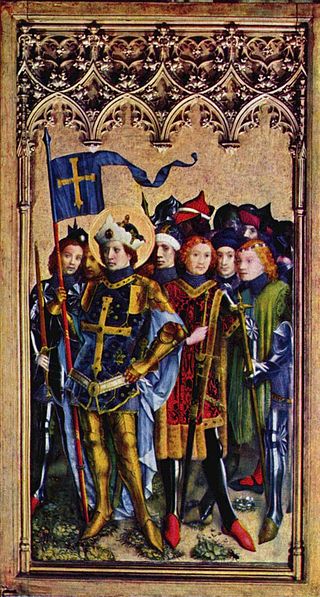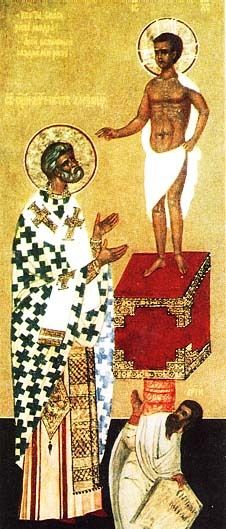Related Research Articles
Pope Marcellinus was the bishop of Rome from 30 June 296 to his death in 304. A historical accusation was levelled at him by some sources to the effect that he might have renounced Christianity during Emperor Diocletian's persecution of Christians before repenting afterwards, which would explain why he is omitted from lists of martyrs. The accusation is rejected, among others, by Augustine of Hippo. He is today venerated as a saint in the Catholic Church and in the Serbian Orthodox Church.

Erasmus of Formia, also known as Saint Elmo, was a Christian saint and martyr. He is venerated as the patron saint of sailors and abdominal pain. Erasmus or Elmo is also one of the Fourteen Holy Helpers, saintly figures of Christian tradition who are venerated especially as intercessors.

The Theban Legion figures in Christian hagiography as a Roman legion from Egypt—"six thousand six hundred and sixty-six men"— Christians who were martyred together in 286, according to the hagiographies of Maurice, the chief among the Legion's saints. Their feast day is held on September 22.

Pancras was a Roman citizen who converted to Christianity and was beheaded for his faith at the age of fourteen, around the year 304. His name is Greek (Πανκράτιος) and means "the one that holds everything".

Euphemia, known as the All-praised in the Eastern Orthodox Church, was a virgin martyr, who died for her faith at Chalcedon in 303 AD.
Combing, sometimes known as carding is a sometimes-fatal form of torture in which iron combs designed to prepare wool and other fibres for woolen spinning are used to scrape, tear, and flay the victim's flesh.
Otimus is a 3rd-century Egyptian martyr and saint. Otimus was born in Fowwa, and later became its priest. After some time, he moved to the mountain of Ansena. When Emperor Diocletian incited his persecution against the Christians, Arianus the governor of Ansena called for Otimus and ordered him to worship the idols. When Otimus refused, Arianus tortured him and eventually ordered him to be burned on 3 Pashons. The relics of Otimus are believed to be in the city of Kalabsha.
Abāmūn of Tarnūt is a saint and was a martyr of the fourth-century Coptic Church. He is known only from his name being mentioned in the Synaxarion of Mikhail of Atrib (c.1240). His feast day is 3 August.
Saint Colluthus is a Coptic saint and martyr of the 3rd century AD said to be from Antinoöpolis.
Rictius Varus was a Vicarius in Roman Gaul at the end of the 3rd century, around the time of the Diocletianic Persecution. The Roman Martyrology contains many references to the prefect Rixius Varus, who is said to have persecuted hundreds of Christians. In Christian hagiography he later repented and became a Christian martyr himself, and is regarded a Saint in the Eastern Orthodox and Roman Catholic Churches, with his feast day on July 6.

Pope Peter I of Alexandria was the 17th Pope and Patriarch of Alexandria. He is revered as a saint by the Coptic Orthodox Church, the Eastern Orthodox Church, and the Catholic Church.

Mercurius was a Roman soldier of Scythian descent who became a Christian saint and martyr. He was born in the city of Eskentos in Cappadocia, in Eastern Asia Minor. According to Christian tradition, he was the soldier who killed Julian the apostate during his campaign in Persia. Saint Mercurius was also widely known by his Arabic-language name Abu-Sayfain, Abu-Sifin or Abu-Sefein in Egyptian Arabic which means "father of two swords", referring to the second sword given to him by the Archangel Michael.

Saint Demiana and the 40 Virgins was a Coptic martyr of the early fourth century.
George El Mozahem was a Coptic Orthodox martyr and saint.

Abanoub or Abanop or Abanoub Al-Nahisy, is a 4th-century Christian saint and martyr from Egypt. His name means Father of Gold in Coptic. He was born in Nehisa in the Nile Delta to Christian parents. Abanoub was 12 years old when he was killed and beheaded, after being tortured for refusing to leave Christianity. His feast day is July 31. His relics are preserved in St.Virgin Mary and St.Abanoub Churches in Sebennytos, Egypt. His title is often The Child Martyr.

Abaskhiron the Soldier or Eskhayron the Soldier is a Coptic martyr and saint. The name "Abaskhyron" is derived from two words, The honorific title "Abba" which means father, is given to him out of respect. The second part of the name, "skhyron", sometimes "eshseros", "eskaros", means the strong.
Saint Wdamun (also Wadamoun, Wdamon, Wdammon, Wdamen, Eudaemon or Saint Wadamoun El Armanty is the first Coptic Christian martyr in Upper Egypt.
Saint Wanas was a Coptic child martyr born to poor parents from Thebes, Egypt. He is venerated as the patron saint of lost things.
Paremhat 7 - Coptic Calendar - Paremhat 9
References
- ↑ "Saint Arianus - Coptic wiki"
- ↑ "The Martyrdom of St. Apamon (Abba Amoun)", St Takla
- ↑ "The Departure of St. Otimus, the Priest", St Takla
- ↑ "The Martyrdom of St. Abaskhiroun the Soldier", St Takla
- ↑ "The Martyrdom of St. Claudius", St Takla
- ↑ "The Martyrdom of St. Arianus, the Governor of Ansena", St Takla
